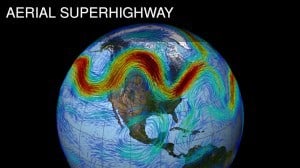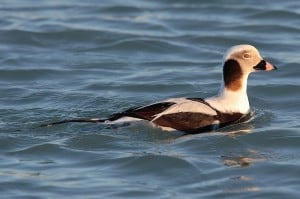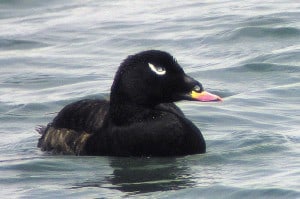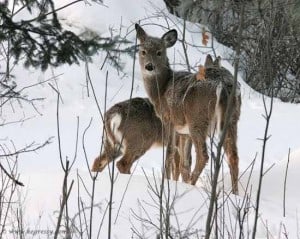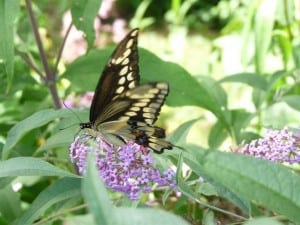By just about any measure, we have had a crazy winter, and not just in eastern North America. With near-record drought in California, unprecedented floods in England and unparalleled warmth in Alaska, it has been a winter of frightening extremes.
Dr. Jennifer Francis, a climatologist at Rutgers University in New Jersey, has an hypothesis as to what may be causing these conditions and why the weather patterns have hung around for so long. Her research points to a rapidly warming Arctic – a result of climate change – as a likely culprit. Francis’s hypothesis goes like this: The temperature difference between the Arctic and the mid-latitudes is a main driver of the Jet Stream, the river of high-altitude air that flows from west to east and rings the entire globe. The Jet Stream marks the boundary between cold, polar air to the north and warm tropical air to the south. It also determines much of our weather. The greater the temperature difference between the Arctic and the mid-latitudes, the faster the air flows and the straighter is its path across the northern hemisphere. However, because the Arctic is warming so much faster than areas further south, this temperature difference has decreased. This, in turn, has led to a weaker Jet Stream which is more easily deflected off its usual course. The flow of air has collapsed into a much more meandering route – think of a slow moving river – with big swings north and south. According to Francis, it has essentially become “stuck” in this new, wavy shape. In eastern North America, where the Jet Stream has plunged far southward, frigid Arctic air has been able to move much further south than usual; over Alaska, warm weather has been able to move much further north.
However, the science of attributing weather events at lower latitudes to what happens in the Arctic is still very new, and scientists are still far from a consensus as to what is actually happening. Some believe that the path of the Jet Stream can change due to natural variability. Obviously, more research is necessary.
Ducks and owls
While it may be too early to know if the long-lasting, frigid winter weather is a result of climate change or simply due to natural variation, we still have to cope with it, as do wild plants and animals. And, although wildlife is supremely adapted to surviving deep snow and intense cold, that doesn’t mean that getting through the winter is easy. Just ask the rarely-seen ducks and grebes on the Otonabee River. Local birders started noticing uncommon species turning up back in December and January – species that are usually restricted to the Great Lakes in winter. Red-necked Grebes, Horned Grebes, Long-tailed Ducks, White-winged Scoters and Red-breasted Mergansers all began to appear. None of these species is usually found here in winter and especially not in the numbers that we have seen. At least four Red-necked Grebes are on the river and as many as 12 Red-breasted Mergansers.
Birders therefore wondered why these species are here. Well, we now have a plausible explanation – ice. Waterfowl have been literally “frozen out” of the Great Lakes. As of March 4, the lakes were about 90.5 per cent ice covered. The record high is 94.7 per cent and there’s every possibility that this record could fall. Only Lake Ontario, which is about 45 per cent iced over, has resisted the trend. With the Great Lakes almost completely frozen, many waterfowl have fled inland in search of areas of open water to rest and feed. The birds that are turning up in the Kawarthas have probably arrived from Georgian Bay. Many of the same species have been popping up on inland lakes and rivers in the eastern U.S. as well. If you want to go out and see some of these ducks yourself, take a slow drive along River Road between Peterborough and Lakefield or take a walk at Lock 19 in Peterborough. If you’re lucky, you may get particularly close-up views of several species.
This winter has also seen the largest Snowy Owl invasion into northeastern North America in five decades. Many people have therefore been wondering how the owls are faring, given the ice and snow. I, too, have been concerned, especially with the freezing rain we had in January which resulted in a centimetre of hard ice on top of the snow. This makes hunting difficult for owls, because they sometimes have to break through the snow and ice to catch the rodents underneath. Well, from all accounts so far, the birds seem to be doing quite well. According to Don Sutherland, zoologist at the Natural Heritage Information Centre here in Peterborough, raptor surveys in southern Ontario have not turned up any starving owls or hawks. “What we have noticed is that inland (away from the Great Lakes), Snowy Owls are concentrated in areas where the snow has been blown off fields and are rare or absent in areas with deeper snow cover. This is also true for Snow Buntings. Both of these species are most common in areas with low snow cover and areas of exposed earth and grasses.” Both of our local Snowies (one on County Road 19 at Chemong Road and one on Scriven Road at County Road 2) seem to be finding enough to eat. Most of their diet probably consists of Meadow Voles, which are usually the most abundant small mammals in fields. Snowy Owls are opportunistic, however, and will eat most anything. Eastern Cottontails are very common this year, so they are undoubtedly an important prey item.
Questions
Questions remain as to how this winter’s weather will have affected some of our more vulnerable species. For example, will the intense cold have killed significant numbers of southern trees (e.g., Hackberry, Sycamore, Tulip Tree) that have been planted in parts of the Kawartha in recent years? How will Giant Swallowtail butterflies have fared? Will the over-wintering pupae (chrysalides) of this southern newcomer to central Ontario have fallen victim to the cold? And what about Emerald Ash Borer larvae? Has it been cold enough to reduce the population to any extent? Although the larvae can withstand cold temperatures by producing an antifreeze compound called glycerol, they are vulnerable if it gets to -30 C. So far, though, it doesn’t look like much mortality is occurring. Ash cuttings infested with Emerald Ash Borer larvae were stored in containers outside the Great Lakes Forest Centre in Sault Ste. Marie this winter. When some of the containers were recently brought indoors, adult beetles soon emerged. Unfortunately, even temperatures way up in the Sault haven’t killed these insects. Finally, White-tailed Deer are particularly susceptible to severe winter conditions. Even during a normal winter, a deer will lose 10-20 per cent of its body weight, since winter browse is inadequate to sustain them for long. With extremely deep snow in some areas – especially north of Lake Huron – the animals are expending a lot of energy simply getting to the food. A late spring and green up could cause high levels of mortality. Fortunately, the Ministry of Natural Resources is closely monitoring the situation.
